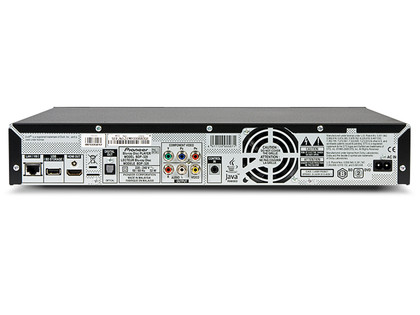TechRadar Verdict
Pioneer has achieved excellent picture and sound quality by eschewing fancy features
Pros
- +
Excellent build quality
- +
Strong picture and audio playback
Cons
- -
Slow startup and play
- -
No multichannel outputs
- -
Expensive
Why you can trust TechRadar
Pioneer's new Blu-ray player, the BDP-320, shuns the bells and whistles that the budget players are currently competing on to concentrate entirely on picture and sound quality.
It's a refreshing change and a welcome move for videophiles, but is the price realistic?
Of course, there are some feature boxes even the most streamlined BD player must tick, so you can count on CD and DVD compatibility with 1080p upscaling and 24fps output and full BD Live capability.
But you can forget about watching YouTube clips via the Ethernet connection, and the USB port is just for storing downloaded BD Live content and not for loading JPEGs or playing MP3s from a flash memory drive.
There's no wi-fi connectivity, or networking with a PC, either, and unlike the US model, there's no 7.1 multichannel output for listening to DTS HD Master Audio tracks, which will be a blow for anyone with an older AV receiver without the necessary decoding.

What this performance-driven deck does have in spades, though, is video and audio processing to wring every last drop of quality from your Blu-ray, DVD and even CD collections.
It's the only BD player to include audio-only circuitry for stereo music playback, for instance. The so-called PQLS feature is designed to work with a compatible Pioneer amp, and enables you to enjoy clear, jitter-free sounds from the analogue audio outputs.
Sign up for breaking news, reviews, opinion, top tech deals, and more.
And instead of multichannel outputs, the Dolby TrueHD and DTS HD Master Audio Essential tracks are pushed through the HDMI cable. That last term, by the way, is what DTS calls the bundle of audio codecs that includes the new formats such as HD Master Audio.
It's also the first player to introduce 48-bit Deep Color to better maintain the hues in HD material when played on a compatible TV. In fact, current screen technology can only handle up to 36-bit processing, but it's always satisfying to be ahead of the curve, and the x.v.Color system already includes 1.8 times as many colours as a regular RGB signal.
Ease of use
Unlike Pioneer's entry-level machine, which was a joint effort with Sharp and had a generic, but clunky interface, this is all Pioneer's own work, and the onscreen display is far more polished, with crisp text on backgrounds that imitate the maker's signature brushed black metal components.
It's also well thought out, with a quick setup guide that asks you what type of display you're connecting to and optimises the output accordingly. All BD players should offer this obvious feature, in our view, and if you're lucky enough to own a Pioneer plasma, you can also use Kuro Link to sync your devices and use just one remote control.

With a decent build quality, it's quite a handful, not overly complicated and has a prominent Home button to take you to the main menu page. But while the user interface is fast enough, the load and play time is still painfully slow and takes signifi cantly longer to play a Blu-ray than rivals from Sony and Samsung.
Picture
Image quality is where this deck scores most of its points, showing off impressive black levels and using the x.v.Color system to full effect by painting bold and rich colours onscreen. There's no visible video noise or banding, either, so large white areas, instead of highlighting any pixel blocking artefacts, simply look clean and bright.
There aren't too many dazzling scenes in the moody Watchmen adaptation, but the Blu-ray offers up the movie's smooth editing and its slick production really shines through on this Pioneer player.
The slo-mo credits at the start of the film look perfect, with the high contrast of the Pioneer helping to pick out detail in the darker shots and the natural colours giving skin and backgrounds a realistic tone.
Partnered with a 1080p/24fpscompatible screen, the Pioneer not only delivers near-perfect, full HD pictures, but also does an excellent job of upscaling DVD movies from standard definition. You can choose the resolution you prefer, but the 1080p output looks remarkably smooth and accurate.
On a really big screen, you'll notice some shimmer in the background, but in general, the upconverted image is cleaner and sharper than the budget upscalers can manage.
Sound
The audio is often an afterthought for Blu-ray players, but Pioneer anticipates that not everyone will simply connect an HDMI lead and leave it at that.
Accordingly, the PQLS system has been developed to optimise the analogue stereo output and there's a tangible improvement in the openness and musicality when you're listening to stereo CDs, which means you can finally consign your old CD player to the attic alongside the VCR.
Sadly, there's still no Super Audio CD or DVD Audio compatibility at this level. For movies, it's a case of using the HDMI link, in lieu of a multichannel output, and this will give you crisp surround sound in all fl avours from Dolby and DTS.
Value
Anyone expecting whizzy new features to go with the high price will be disappointed. Home cinema purists and Pioneer fans, on the other hand, can consider this a perfectly executed all-rounder that delivers top quality audio and video without the multimedia juggling or web surfing, which aren't strictly necessary on a Blu-ray player.
Follow TechRadar Reviews on Twitter: http://twitter.com/techradarreview

Jim has been evaluating printers for more than twenty years and has, to date, written over a hundred reviews for TechRadar Pro. From pocket printers to industrial dye sublimation, Jim has been there, run the tests and printed the t-shirt. His expertise extends to consumables (paper, ink, toner) and his printer buying guides make it easy to compare these essential peripherals.
